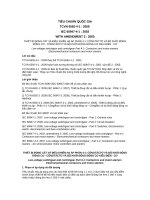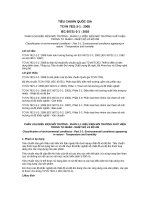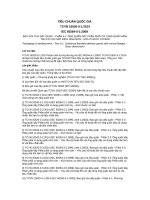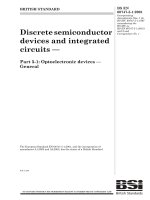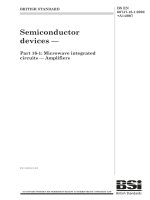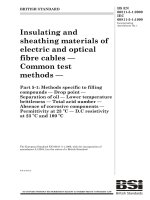Iec 60747 5 1 2002
Bạn đang xem bản rút gọn của tài liệu. Xem và tải ngay bản đầy đủ của tài liệu tại đây (884.37 KB, 74 trang )
NORME
INTERNATIONALE
INTERNATIONAL
STANDARD
CEI
IEC
60747-5-1
Edition 1.2
2002-05
Edition 1:1997 consolidée par les amendements 1:2001 et 2:2002
Edition 1:1997 consolidated with amendments 1:2001 and 2:2002
Partie 5-1:
Dispositifs optoélectroniques –
Généralités
Discrete semiconductor devices
and integrated circuits –
Part 5-1:
Optoelectronic devices –
General
Numéro de référence
Reference number
CEI/IEC 60747-5-1:1997+A1:2001+A2:2002
LICENSED TO MECON Limited. - RANCHI/BANGALORE
FOR INTERNAL USE AT THIS LOCATION ONLY, SUPPLIED BY BOOK SUPPLY BUREAU.
Dispositifs discrets à semiconducteurs
et circuits intégrés –
Publication numbering
Depuis le 1er janvier 1997, les publications de la CEI
sont numérotées à partir de 60000. Ainsi, la CEI 34-1
devient la CEI 60034-1.
As from 1 January 1997 all IEC publications are
issued with a designation in the 60000 series. For
example, IEC 34-1 is now referred to as IEC 60034-1.
Editions consolidées
Consolidated editions
Les versions consolidées de certaines publications de la
CEI incorporant les amendements sont disponibles. Par
exemple, les numéros d’édition 1.0, 1.1 et 1.2 indiquent
respectivement la publication de base, la publication de
base incorporant l’amendement 1, et la publication de
base incorporant les amendements 1 et 2.
The IEC is now publishing consolidated versions of its
publications. For example, edition numbers 1.0, 1.1
and 1.2 refer, respectively, to the base publication,
the base publication incorporating amendment 1 and
the base publication incorporating amendments 1
and 2.
Informations supplémentaires
sur les publications de la CEI
Further information on IEC publications
Le contenu technique des publications de la CEI est
constamment revu par la CEI afin qu'il reflète l'état
actuel de la technique. Des renseignements relatifs à
cette publication, y compris sa validité, sont disponibles dans le Catalogue des publications de la CEI
(voir ci-dessous) en plus des nouvelles éditions,
amendements et corrigenda. Des informations sur les
sujets à l’étude et l’avancement des travaux entrepris
par le comité d’études qui a élaboré cette publication,
ainsi que la liste des publications parues, sont
également disponibles par l’intermédiaire de:
The technical content of IEC publications is kept
under constant review by the IEC, thus ensuring that
the content reflects current technology. Information
relating to this publication, including its validity, is
available in the IEC Catalogue of publications
(see below) in addition to new editions, amendments
and corrigenda. Information on the subjects under
consideration and work in progress undertaken by the
technical committee which has prepared this
publication, as well as the list of publications issued,
is also available from the following:
•
Site web de la CEI (www.iec.ch)
•
IEC Web Site (www.iec.ch)
•
Catalogue des publications de la CEI
•
Catalogue of IEC publications
Le catalogue en ligne sur le site web de la CEI
(www.iec.ch/catlg-f.htm) vous permet de faire des
recherches en utilisant de nombreux critères,
comprenant des recherches textuelles, par comité
d’études ou date de publication. Des informations
en ligne sont également disponibles sur les
nouvelles publications, les publications remplacées ou retirées, ainsi que sur les corrigenda.
•
IEC Just Published
The on-line catalogue on the IEC web site
(www.iec.ch/catlg-e.htm) enables you to search
by a variety of criteria including text searches,
technical committees and date of publication. Online information is also available on recently
issued publications, withdrawn and replaced
publications, as well as corrigenda.
•
Ce résumé des dernières publications parues
(www.iec.ch/JP.htm) est aussi disponible par
courrier électronique. Veuillez prendre contact
avec le Service client (voir ci-dessous) pour plus
d’informations.
•
Service clients
IEC Just Published
This summary of recently issued publications
(www.iec.ch/JP.htm) is also available by email.
Please contact the Customer Service Centre (see
below) for further information.
•
Customer Service Centre
Si vous avez des questions au sujet de cette
publication ou avez besoin de renseignements
supplémentaires, prenez contact avec le Service
clients:
If you have any questions regarding this
publication or need further assistance, please
contact the Customer Service Centre:
Email:
Tél:
+41 22 919 02 11
Fax: +41 22 919 03 00
Email:
Tel:
+41 22 919 02 11
Fax: +41 22 919 03 00
.
LICENSED TO MECON Limited. - RANCHI/BANGALORE
FOR INTERNAL USE AT THIS LOCATION ONLY, SUPPLIED BY BOOK SUPPLY BUREAU.
Numérotation des publications
NORME
INTERNATIONALE
INTERNATIONAL
STANDARD
CEI
IEC
60747-5-1
Edition 1.2
2002-05
Edition 1:1997 consolidée par les amendements 1:2001 et 2:2002
Edition 1:1997 consolidated with amendments 1:2001 and 2:2002
LICENSED TO MECON Limited. - RANCHI/BANGALORE
FOR INTERNAL USE AT THIS LOCATION ONLY, SUPPLIED BY BOOK SUPPLY BUREAU.
Dispositifs discrets à semiconducteurs
et circuits intégrés –
Partie 5-1:
Dispositifs optoélectroniques –
Généralités
Discrete semiconductor devices
and integrated circuits –
Part 5-1:
Optoelectronic devices –
General
IEC 2002 Droits de reproduction réservés Copyright - all rights reserved
Aucune partie de cette publication ne peut être reproduite ni
utilisée sous quelque forme que ce soit et par aucun procédé,
électronique ou mécanique, y compris la photocopie et les
microfilms, sans l'accord écrit de l'éditeur.
No part of this publication may be reproduced or utilized in
any form or by any means, electronic or mechanical,
including photocopying and microfilm, without permission in
writing from the publisher.
International Electrotechnical Commission
3, rue de Varembé Geneva, Switzerland
Telefax: +41 22 919 0300
e-mail:
IEC web site
Commission Electrotechnique Internationale
International Electrotechnical Commission
CODE PRIX
PRICE CODE
CH
Pour prix, voir catalogue en vigueur
For price, see current catalogue
–2–
60747-5-1 © CEI:1997+A1:2001+A2:2002
SOMMAIRE
AVANT-PROPOS ....................................................................................................................6
INTRODUCTION ................................................................................................................... 10
1
Domaine d'application ..................................................................................................... 12
2
Références normatives ................................................................................................... 12
3
Concepts physiques ........................................................................................................ 12
3.1
4
Types de dispositifs ........................................................................................................ 14
4.1
4.2
4.3
4.4
4.5
4.6
4.7
4.8
4.9
4.10
4.11
4.12
4.13
5
Termes généraux............................................................................................................ 18
5.1
5.2
5.3
6
Dispositif optoélectronique à semiconducteurs ....................................................... 14
Photoémetteur à semiconducteurs ......................................................................... 14
Laser à semiconducteurs ....................................................................................... 14
Diode électroluminescente ..................................................................................... 16
Diode émettrice en infrarouge ................................................................................ 16
Dispositif photosensible (à semiconducteurs) ......................................................... 16
Récepteur photoélectrique (à semiconducteurs) ..................................................... 16
Photorésistance (à semiconducteurs), cellule photoconductrice
(VEI 845-05-37, spécialisé) .................................................................................... 16
Photopile, cellule photovoltaïque (VEI 845-05-38) .................................................. 16
Photodiode (VEI 845-05-39)................................................................................... 16
Phototransistor ...................................................................................................... 16
Photothyristor ........................................................................................................ 16
Photocoupleur, optocoupleur ................................................................................. 16
Axe optique ........................................................................................................... 18
Accès optique (d'un dispositif optoélectronique à semiconducteurs) ....................... 20
Gaine (optique) (VEI 731-02-05) ............................................................................ 26
Termes relatifs aux valeurs limites et aux caractéristiques .............................................. 28
6.1
6.2
6.3
6.4
Généralités ............................................................................................................ 28
Photoémetteurs ..................................................................................................... 30
Dispositifs photosensibles...................................................................................... 48
Photocoupleurs, optocoupleurs .............................................................................. 54
Annexe A (informative) Index des références croisées .......................................................... 68
LICENSED TO MECON Limited. - RANCHI/BANGALORE
FOR INTERNAL USE AT THIS LOCATION ONLY, SUPPLIED BY BOOK SUPPLY BUREAU.
3.2
3.3
3.4
3.5
3.6
3.7
Rayonnement (électromagnétique); radiation (électromagnétique)
(VEI 845-01-01) ..................................................................................................... 12
Rayonnement optique (VEI 845-01-02)................................................................... 12
Rayonnement visible (VEI 845-01-03) .................................................................... 12
Rayonnement infrarouge (VEI 845-01-04, spécialisé) ............................................. 14
Rayonnement ultraviolet (VEI 845-01-05, spécialisé) .............................................. 14
Lumière (VEI 845-01-06)........................................................................................ 14
Effet photoélectrique (extrait de VEI 845-05-33: récepteur photoélectrique) ............ 14
60747-5-1 © IEC:1997+A1:2001+A2:2002
–3–
CONTENTS
FOREWORD...........................................................................................................................7
INTRODUCTION ................................................................................................................... 11
1
Scope ............................................................................................................................. 13
2
Normative references...................................................................................................... 13
3
Physical concepts ........................................................................................................... 13
4
Types of devices............................................................................................................. 15
4.1
4.2
4.3
4.4
4.5
4.6
4.7
4.8
4.9
4.10
4.11
4.12
4.13
5
Semiconductor optoelectronic device ..................................................................... 15
Semiconductor photoemitter .................................................................................. 15
Semiconductor laser .............................................................................................. 15
Light-emitting diode (LED) ..................................................................................... 17
Infrared-emitting diode (IRED) ............................................................................... 17
(Semiconductor) photosensitive device .................................................................. 17
(Semiconductor) photoelectric detector .................................................................. 17
(Semiconductor) photoresistor, photoconductive cell
(IEV 845-05-37, specialized) .................................................................................. 17
Photoelement, photovoltaic cell (IEV 845-05-38) .................................................... 17
Photodiode (IEV 845-05-39)................................................................................... 17
Phototransistor ...................................................................................................... 17
Photothyristor ........................................................................................................ 17
Photocoupler, optocoupler ..................................................................................... 17
General terms................................................................................................................. 19
5.1
5.2
5.3
6
(Electromagnetic) radiation (IEV 845-01-01)........................................................... 13
Optical radiation (IEV 845-01-02) ........................................................................... 13
Visible radiation (IEV 845-01-03)............................................................................ 13
Infrared radiation (IEV 845-01-04, specialized) ....................................................... 15
Ultraviolet radiation (IEV 845-01-05, specialized) ................................................... 15
Light (IEV 845-01-06) ............................................................................................ 15
Photoelectric effect (from IEV 845-05-33: photoelectric detector) ........................... 15
Optical axis ........................................................................................................... 19
Optical port (of a semiconductor optoelectronic device) .......................................... 21
(Optical) cladding (IEV 731-02-05) ......................................................................... 27
Terms related to ratings and characteristics .................................................................... 29
6.1
6.2
6.3
6.4
General ................................................................................................................. 29
Photoemitters ........................................................................................................ 31
Photosensitive devices .......................................................................................... 49
Photocouplers, optocouplers .................................................................................. 55
Annex A (informative) Cross references index ...................................................................... 69
LICENSED TO MECON Limited. - RANCHI/BANGALORE
FOR INTERNAL USE AT THIS LOCATION ONLY, SUPPLIED BY BOOK SUPPLY BUREAU.
3.1
3.2
3.3
3.4
3.5
3.6
3.7
–4–
60747-5-1 © CEI:1997+A1:2001+A2:2002
Figure 1a – Dispositif avec fibre amorce nue ......................................................................... 20
Figure 1b – Dispositif avec fibre amorce et connecteur .......................................................... 22
Figure 2a – Dispositif avec fenêtre, mais sans lentille ............................................................ 22
Figure 2b – Récepteur avec fenêtre, mais sans lentille (pastille référencée)........................... 24
Figure 2c – Récepteur avec lentille........................................................................................ 24
Figure 2d – Diode émettrice en infrarouge avec accès optique non situé sur la fenêtre
extérieure du btier .............................................................................................................. 26
Figure 3 – Dispositifs sans btier (émetteur ou récepteur) et sans fibre amorce .................... 26
Figure 4 – Temps de commutation ........................................................................................ 30
Figure 5 – Courant de seuil d'une diode laser ........................................................................ 36
Figure 6 – Diagramme de rayonnement et caractéristiques correspondantes ......................... 38
Figure 8 – Caractéristiques spectrales des diodes laser et des modules à diodes laser .......... 40
Figure 9 – Rapport de suppression de mode proche .............................................................. 44
Figure 10 – Source d'émission d'une diode laser ................................................................... 46
Figure 11 – Sensibilité à l'entrée S FD ..................................................................................... 50
Figure 12 – Diagramme de sensibilité et caractéristiques correspondantes ............................ 52
Figure 13 – Facteur de multiplication d'une diode à avalanche ............................................... 52
Figure 14 – Intervalles de temps de la tension d'essai ........................................................... 62
LICENSED TO MECON Limited. - RANCHI/BANGALORE
FOR INTERNAL USE AT THIS LOCATION ONLY, SUPPLIED BY BOOK SUPPLY BUREAU.
Figure 7 – Caractéristiques spectrales des diodes électroluminescentes et des diodes
émettrices en infrarouge........................................................................................................ 40
60747-5-1 © IEC:1997+A1:2001+A2:2002
–5–
Figure 1a – Device with bare fibre pigtail ............................................................................... 21
Figure 1b – Device with fibre pigtail connector attached ......................................................... 23
Figure 2a – Device with window, but without lens ................................................................... 23
Figure 2b – Detector with window, but without lens (chip referenced) ..................................... 25
Figure 2c – Detector with lens ............................................................................................... 25
Figure 2d – IRED with optical port that is not located on the output window
of the package ...................................................................................................................... 27
Figure 3 – Non-packaged devices (emitter or detector) without pigtail .................................... 27
Figure 4 – Switching times .................................................................................................... 31
Figure 5 – Threshold current of a laser diode......................................................................... 37
Figure 6 – Radiation diagram and related characteristics ....................................................... 39
Figure 8 – Spectral characteristics of laser diodes and laser-diode modules .......................... 41
Figure 9 – Side-mode suppression ratio................................................................................. 45
Figure 10 – Emission source of a laser diode......................................................................... 47
Figure 11 – Fibre-input sensitivity S FD ................................................................................... 51
Figure 12 – Sensitivity diagram and related characteristics .................................................... 53
Figure 13 – Multiplication factor of an avalanche diode .......................................................... 53
Figure 14 – Time intervals of the test voltage......................................................................... 63
LICENSED TO MECON Limited. - RANCHI/BANGALORE
FOR INTERNAL USE AT THIS LOCATION ONLY, SUPPLIED BY BOOK SUPPLY BUREAU.
Figure 7 – Spectral characteristics of light-emitting diodes and infrared-emitting diodes ......... 41
–6–
60747-5-1 © CEI:1997+A1:2001+A2:2002
COMMISSION ÉLECTROTECHNIQUE INTERNATIONALE
____________
DISPOSITIFS DISCRETS À SEMICONDUCTEURS
ET CIRCUITS INTÉGRÉS –
Partie 5-1: Dispositifs optoélectroniques –
Généralités
1) La CEI (Commission Electrotechnique Internationale) est une organisation mondiale de normalisation composée
de l'ensemble des comités électrotechniques nationaux (Comités nationaux de la CEI). La CEI a pour objet de
favoriser la coopération internationale pour toutes les questions de normalisation dans les domaines de
l'électricité et de l'électronique. A cet effet, la CEI, entre autres activités, publie des Normes internationales.
Leur élaboration est confiée à des comités d'études, aux travaux desquels tout Comité national intéressé par le
sujet traité peut participer. Les organisations internationales, gouvernementales et non gouvernementales, en
liaison avec la CEI, participent également aux travaux. La CEI collabore étroitement avec l'Organisation
Internationale de Normalisation (ISO), selon des conditions fixées par accord entre les deux organisations.
2) Les décisions ou accords officiels de la CEI concernant les questions techniques représentent, dans la mesure
du possible, un accord international sur les sujets étudiés, étant donné que les Comités nationaux intéressés
sont représentés dans chaque comité d’études.
3) Les documents produits se présentent sous la forme de recommandations internationales. Ils sont publiés
comme normes, spécifications techniques, rapports techniques ou guides et agréés comme tels par les Comités
nationaux.
4) Dans le but d'encourager l'unification internationale, les Comités nationaux de la CEI s'engagent appliquer de
faỗon transparente, dans toute la mesure possible, les Normes internationales de la CEI dans leurs normes
nationales et régionales. Toute divergence entre la norme de la CEI et la norme nationale ou régionale
correspondante doit être indiquée en termes clairs dans cette dernière.
5) La CEI n’a fixé aucune procédure concernant le marquage comme indication d’approbation et sa responsabilité
n’est pas engagée quand un matériel est déclaré conforme à l’une de ses normes.
6) L’attention est attirée sur le fait que certains des éléments de la présente Norme internationale peuvent faire
l’objet de droits de propriété intellectuelle ou de droits analogues. La CEI ne saurait être tenue pour
responsable de ne pas avoir identifié de tels droits de propriété et de ne pas avoir signalé leur existence.
La Norme internationale CEI 60747-5-1 a été établie par le sous-comité 47E: Dispositifs
discrets à semiconducteurs, du comité d’études 47 de la CEI: Dispositifs à semiconducteurs. 1)
Cette première édition remplace partiellement la deuxième édition de la CEI 60747-5 (1992) et
constitue une révision technique. (Voir également annexe A: Index des références croisées).
Elle doit être lue conjointement avec la CEI 60747-1, la CEI 62007-1 et la CEI 62007-2.
La présente version consolidée de la CEI 60747-5-1 est issue de la première édition (1997)
[documents 47C/173/FDIS et 47C/186/RVD], de son amendement 1 (2001) [documents
47E/178/FDIS et 47E/184/RVD] et de son amendement 2 (2002) [documents 47E/208/FDIS et
47E/213/RVD].
Elle porte le numéro d'édition 1.2.
Une ligne verticale dans la marge indique où la publication de base a été modifiée par les
amendements 1 et 2.
L'annexe A est donnée uniquement à titre d'information.
________
1)
A l'origine, cette publication a été préparée par le SC 47C, mais c'est le SC 47E qui a repris les activités du SC 47C.
LICENSED TO MECON Limited. - RANCHI/BANGALORE
FOR INTERNAL USE AT THIS LOCATION ONLY, SUPPLIED BY BOOK SUPPLY BUREAU.
AVANT-PROPOS
60747-5-1 © IEC:1997+A1:2001+A2:2002
–7–
INTERNATIONAL ELECTROTECHNICAL COMMISSION
____________
DISCRETE SEMICONDUCTOR DEVICES
AND INTEGRATED CIRCUITS –
Part 5-1: Optoelectronic devices –
General
1) The IEC (International Electrotechnical Commission) is a worldwide organization for standardization comprising
all national electrotechnical committees (IEC National Committees). The object of the IEC is to promote
international co-operation on all questions concerning standardization in the electrical and electronic fields. To
this end and in addition to other activities, the IEC publishes International Standards. Their preparation is
entrusted to technical committees; any IEC National Committee interested in the subject dealt with may
participate in this preparatory work. International, governmental and non-governmental organizations liaising
with the IEC also participate in this preparation. The IEC collaborates closely with the International Organization
for Standardization (ISO) in accordance with conditions determined by agreement between the two
organizations.
2) The formal decisions or agreements of the IEC on technical matters express, as nearly as possible, an
international consensus of opinion on the relevant subjects since each technical committee has representation
from all interested National Committees.
3) The documents produced have the form of recommendations for international use and are published in the form
of standards, technical specifications, technical reports or guides and they are accepted by the National
Committees in that sense.
4) In order to promote international unification, IEC National Committees undertake to apply IEC International
Standards transparently to the maximum extent possible in their national and regional standards. Any
divergence between the IEC Standard and the corresponding national or regional standard shall be clearly
indicated in the latter.
5) The IEC provides no marking procedure to indicate its approval and cannot be rendered responsible for any
equipment declared to be in conformity with one of its standards.
6) Attention is drawn to the possibility that some of the elements of this International Standard may be the subject
of patent rights. The IEC shall not be held responsible for identifying any or all such patent rights.
International Standard IEC 60747-5-1 has been prepared by subcommittee 47E: Discrete semiconductor devices, of IEC technical committee 47: Semiconductor devices. 1)
This first edition replaces partially the second edition of IEC 60747-5 (1992) and constitutes a
technical revision (see also annex A: Cross references index).
It should be read jointly with IEC 60747-1 and IEC 62007-1 and IEC 62007-2.
This consolidated version of IEC 60747-5-1 is based on the first edition (1997) [documents
47C/173/FDIS and 47C/186/RVD], its amendment 1 (2001) [documents 47E/178/FDIS and
47E/184/RVD] and its amendment 2 (2002) [documents 47E/208/FDIS and 47E/213/RVD].
It bears the edition number 1.2.
A vertical line in the margin shows where the base publication has been modified by
amendments 1 and 2.
Annex A is for information only.
________
1)
Originally this publication was prepared by SC 47C, but SC 47E has taken over SC 47C activities.
LICENSED TO MECON Limited. - RANCHI/BANGALORE
FOR INTERNAL USE AT THIS LOCATION ONLY, SUPPLIED BY BOOK SUPPLY BUREAU.
FOREWORD
–8–
60747-5-1 © CEI:1997+A1:2001+A2:2002
Le comité a décidé que le contenu de cette publication de base et de ses amendements ne
sera pas modifié avant 2004. A cette date, la publication sera
•
reconduite;
•
supprimée;
•
remplacée par une édition révisée, ou
•
amendée.
LICENSED TO MECON Limited. - RANCHI/BANGALORE
FOR INTERNAL USE AT THIS LOCATION ONLY, SUPPLIED BY BOOK SUPPLY BUREAU.
60747-5-1 © IEC:1997+A1:2001+A2:2002
–9–
The committee has decided that the contents of the base publication and its amendments will
remain unchanged until 2004. At this date, the publication will be
•
reconfirmed;
•
withdrawn;
•
replaced by a revised edition, or
•
amended.
LICENSED TO MECON Limited. - RANCHI/BANGALORE
FOR INTERNAL USE AT THIS LOCATION ONLY, SUPPLIED BY BOOK SUPPLY BUREAU.
– 10 –
60747-5-1 © CEI:1997+A1:2001+A2:2002
INTRODUCTION
La présente partie de la CEI 60747 fournit des informations de base sur les semiconducteurs:
–
terminologie,
–
symboles littéraux,
–
valeurs limites et caractéristiques essentielles,
–
méthodes de mesure,
–
réception et fiabilité.
LICENSED TO MECON Limited. - RANCHI/BANGALORE
FOR INTERNAL USE AT THIS LOCATION ONLY, SUPPLIED BY BOOK SUPPLY BUREAU.
60747-5-1 © IEC:1997+A1:2001+A2:2002
– 11 –
INTRODUCTION
This part of IEC 60747 provides basic information on semiconductors:
–
terminology,
–
letter symbols,
–
essential ratings and characteristics,
–
measuring methods,
–
acceptance and reliability.
LICENSED TO MECON Limited. - RANCHI/BANGALORE
FOR INTERNAL USE AT THIS LOCATION ONLY, SUPPLIED BY BOOK SUPPLY BUREAU.
– 12 –
60747-5-1 © CEI:1997+A1:2001+A2:2002
DISPOSITIFS DISCRETS À SEMICONDUCTEURS
ET CIRCUITS INTÉGRÉS –
Partie 5-1: Dispositifs optoélectroniques –
Généralités
1 Domaine d'application
Cette partie de la CEI 60747 a pour sujet la terminologie propre aux dispositifs optoélectroniques à semiconducteurs.
Les documents de référence suivants sont indispensables pour l'application du présent
document. Pour les références datées, seule l'édition citée s'applique. Pour les références non
datées, la dernière édition du document de référence s'applique (y compris les éventuels
amendements).
CEI 60050(731):1991, Vocabulaire Electrotechnique International (VEI) – Chapitre 731:
Télécommunications par fibres optiques
CEI 60050(845):1987, Vocabulaire Electrotechnique International (VEI) – Chapitre 845:
Eclairage
CEI 60664-1:1992, Coordination de l'isolement des matériels dans les systèmes (réseaux) à
basse tension – Partie 1: Principes, prescriptions et essais
3 Concepts physiques
3.1 Rayonnement (électromagnétique); radiation (électromagnétique) (VEI 845-01-01)
1) Emission ou transport d'énergie sous forme d'ondes électromagnétiques avec les photons
associés.
2) Ces ondes électromagnétiques ou ces photons.
3.2 Rayonnement optique (VEI 845-01-02)
Rayonnement électromagnétique dont les longueurs d'onde sont comprises entre le domaine
de transition vers les rayons X (≈1 nm) et le domaine de transition vers les ondes radioélectriques (≈1 nm).
3.3 Rayonnement visible (VEI 845-01-03)
Rayonnement optique susceptible de produire directement une sensation visuelle.
NOTE Il n'y a pas de limites précises pour le domaine spectral du rayonnement visible; ces limites dépendent du
flux énergétique disponible et de la sensibilité de l'observateur. La limite inférieure est prise généralement entre
360 nm et 400 nm et la limite supérieure entre 760 nm et 830 nm.
LICENSED TO MECON Limited. - RANCHI/BANGALORE
FOR INTERNAL USE AT THIS LOCATION ONLY, SUPPLIED BY BOOK SUPPLY BUREAU.
2 Références normatives
60747-5-1 © IEC:1997+A1:2001+A2:2002
– 13 –
DISCRETE SEMICONDUCTOR DEVICES
AND INTEGRATED CIRCUITS –
Part 5-1: Optoelectronic devices –
General
1 Scope
This part of IEC 60747 deals with the terminology relating to the semiconductor optoelectronic
devices.
The following referenced documents are indispensable for the application of this document. For
dated references, only the edition cited applies. For undated references, the latest edition of
the referenced document (including any amendments) applies.
IEC 60050(731),1991, International Electrotechnical Vocabulary (IEV) – Chapter 731: Optical
fibre communication
IEC 60050(845):1987, International Electrotechnical Vocabulary (IEV) – Chapter 845: Lighting
IEC 60664-1:1992, Insulation coordination for equipment within low-voltage systems – Part 1:
Principles, requirements and tests
3 Physical concepts
3.1 (Electromagnetic) radiation (IEV 845-01-01)
1) Emission or transfer of energy in the form of electromagnetic waves with the associated
photons.
2) These electromagnetic waves or these photons.
3.2 Optical radiation (IEV 845-01-02)
Electromagnetic radiation of wavelengths lying between the region of transition to X-rays
(≈1 nm) and the region of transition to radio waves (≈1 nm).
3.3 Visible radiation (IEV 845-01-03)
Any optical radiation capable of causing a visual sensation directly.
NOTE There are no precise limits for the spectral range of visible radiation since they depend upon the amount of
radiant power available and the responsivity of the observer. The lower limit is generally taken between 360 nm and
400 nm and the upper limit between 760 nm and 830 nm.
LICENSED TO MECON Limited. - RANCHI/BANGALORE
FOR INTERNAL USE AT THIS LOCATION ONLY, SUPPLIED BY BOOK SUPPLY BUREAU.
2 Normative references
– 14 –
60747-5-1 © CEI:1997+A1:2001+A2:2002
3.4 Rayonnement infrarouge (VEI 845-01-04, spécialisé)
Rayonnement optique dont les longueurs d'onde sont supérieures à celles du rayonnement
visible.
3.5 Rayonnement ultraviolet (VEI 845-01-05, spécialisé)
Rayonnement optique dont les longueurs d'onde sont inférieures à celles du rayonnement
visible.
3.6 Lumière (VEI 845-01-06, sans la note 2 qui n'est pas appropriộe)
3.6.1 Lumiốre perỗue (voir VEI 845-02-17)
NOTE Le concept 2 est parfois employé pour des rayonnements optiques s'étendant en dehors du domaine
visible, mais cet usage n'est pas recommandé.
3.7 Effet photoélectrique (extrait de VEI 845-05-33: récepteur photoélectrique)
Interaction entre le rayonnement optique et la matière résultant de l'absorption de photons et
de la libération consécutive de porteurs de charges mobiles, produisant ainsi une tension ou un
courant électrique, ou un changement de résistance électrique, en excluant tout phénomène
électrique produit par des changements de température.
4 Types de dispositifs
4.1 Dispositif optoélectronique à semiconducteurs
1) Dispositif à semiconducteurs qui émet ou détecte ou est sensible à un rayonnement optique
cohérent ou non cohérent.
2) Dispositif à semiconducteurs qui utilise un tel rayonnement pour son fonctionnement
interne.
4.2 Photoémetteur à semiconducteurs
Dispositif optoélectronique à semiconducteurs qui convertit directement l'énergie électrique en
énergie optique rayonnante.
4.3 Laser à semiconducteurs
4.3.1 Diode laser (à semiconducteurs)
Diode à semiconducteurs qui émet un rayonnement optique cohérent par une émission
stimulée résultant de la recombinaison d'électrons libres et de trous lorsqu'elle est excitée par
un courant électrique de valeur supérieure au courant de seuil de la diode.
NOTE La diode laser est montée sur une embase ou dans un btier avec ou sans moyen de couplage (par
exemple, lentille, fibre amorce).
4.3.2 Module à diode laser
Module qui comprend avec la diode laser un moyen pour la stabilisation optique et/ou
thermique automatique du flux énergétique.
LICENSED TO MECON Limited. - RANCHI/BANGALORE
FOR INTERNAL USE AT THIS LOCATION ONLY, SUPPLIED BY BOOK SUPPLY BUREAU.
3.6.2 Rayonnement visible (voir VEI 845-01-03)
60747-5-1 © IEC:1997+A1:2001+A2:2002
– 15 –
3.4 Infrared radiation (IEV 845-01-04, specialized)
Optical radiation for which the wavelengths are longer than those for visible radiation.
3.5 Ultraviolet radiation (IEV 845-01-05, specialized)
Optical radiation for which the wavelengths are shorter than those for visible radiation.
3.6 Light (IEV 845-01-06, without note 2 which is not relevant)
3.6.1 Perceived light (see IEV 845-02-17)
3.6.2 Visible radiation (see IEV 845-01-03)
3.7 Photoelectric effect (from IEV 845-05-33: photoelectric detector)
Interaction between optical radiation and matter resulting in the absorption of photons and the
consequent generation of mobile charge carriers, thereby generating an electric potential or
current, or a change in electrical resistance, excluding electrical phenomena caused by
temperature changes.
4 Types of devices
4.1 Semiconductor optoelectronic device
1) A semiconductor device that emits or detects or that is responsive to coherent or noncoherent optical radiation.
2) A semiconductor device that utilizes such radiation for its internal purposes.
4.2 Semiconductor photoemitter
A semiconductor optoelectronic device that directly converts electric energy into optical radiant
energy.
4.3 Semiconductor laser
4.3.1
(Semiconductor) laser diode
A semiconductor diode that emits coherent optical radiation through stimulated emission
resulting from the recombination of free electrons and holes when excited by an electric current
that exceeds the threshold current of the diode.
NOTE The laser diode is mounted on a submount or in a package with or without coupling means (e.g. lens,
pigtail).
4.3.2 Laser-diode module
A module containing, together with the laser diode, means for an automatic optical and/or
thermal stabilization of the radiant output power.
LICENSED TO MECON Limited. - RANCHI/BANGALORE
FOR INTERNAL USE AT THIS LOCATION ONLY, SUPPLIED BY BOOK SUPPLY BUREAU.
NOTE Concept 2 is sometimes used for optical radiation extending outside the visible range, but this usage is not
recommended.
– 16 –
60747-5-1 © CEI:1997+A1:2001+A2:2002
4.4 Diode électroluminescente
Diode à semiconducteurs, autre qu'un laser à semiconducteurs, capable d'émettre un
rayonnement visible lorsqu'elle est excitée par un courant électrique.
4.5 Diode émettrice en infrarouge
Diode à semiconducteurs, autre qu'un laser à semiconducteurs, capable d'émettre un
rayonnement en infrarouge lorsqu'elle est excitée par un courant électrique.
4.6 Dispositif photosensible (à semiconducteurs)
Dispositif à semiconducteurs qui utilise l'effet photoélectrique pour détecter un rayonnement
optique.
Dispositif à semiconducteurs qui utilise l'effet photoélectrique pour recevoir un rayonnement
optique.
4.8 Photorésistance (à semiconducteurs), cellule photoconductrice
(VEI 845-05-37, spécialisé)
Récepteur photoélectrique à semiconducteurs qui utilise la variation de la conductivité
électrique produite par l'absorption d'un rayonnement optique.
4.9 Photopile, cellule photovoltaïque (VEI 845-05-38)
Récepteur photoélectrique qui utilise la force électromotrice produite par l'absorption d'un
rayonnement optique.
4.10 Photodiode (VEI 845-05-39)
Récepteur photoélectrique dans lequel un courant photoélectrique est produit par l'absorption
d'un rayonnement optique au voisinage d'une jonction PN entre les semiconducteurs, ou d'une
jonction entre un semiconducteur et un métal.
4.11 Phototransistor
Transistor dans lequel le courant produit par l'effet photoélectrique au voisinage de la jonction
émetteur-base joue le rôle de courant de base qui est amplifiộ.
4.12 Photothyristor
Thyristor qui est conỗu pour être déclenché par un rayonnement optique.
4.13 Photocoupleur, optocoupleur
Dispositif optoélectronique semiconducteurs conỗu pour le transfert de signaux ộlectriques
par l'utilisation d'un rayonnement optique, afin d'assurer un couplage ainsi que l'isolement
électrique entre l'entrée et la sortie.
4.13.1 Photocoupleur/optocoupleur à entrée continue
Photocoupleur/optocoupleur dont l'élément d'entrée est un émetteur optoélectronique auquel
du courant continu est appliqué
LICENSED TO MECON Limited. - RANCHI/BANGALORE
FOR INTERNAL USE AT THIS LOCATION ONLY, SUPPLIED BY BOOK SUPPLY BUREAU.
4.7 Récepteur photoélectrique (à semiconducteurs)
60747-5-1 © IEC:1997+A1:2001+A2:2002
– 17 –
4.4 Light-emitting diode (LED)
A semiconductor diode, other than a semiconductor laser, capable of emitting visible radiation
when excited by an electric current.
4.5 Infrared-emitting diode (IRED)
A semiconductor diode other than a semiconductor laser capable of emitting infrared radiation
when excited by an electric current.
4.6 (Semiconductor) photosensitive device
A semiconductor device that utilizes the photoelectric effect for detection of optical radiation.
A semiconductor device that utilizes the photoelectric effect for detection of optical radiation.
4.8 (Semiconductor) photoresistor, photoconductive cell (IEV 845-05-37, specialized)
A semiconductor photoelectric detector that utilizes the change of electric conductivity
produced by the absorption of optical radiation.
4.9 Photoelement, photovoltaic cell (IEV 845-05-38)
A photoelectric detector that utilizes the electromotive force produced by the absorption of
optical radiation.
4.10 Photodiode (IEV 845-05-39)
A photoelectric detector in which a photocurrent is generated by absorption of optical radiation
in the neighbourhood of a PN junction between the semiconductors, or of a junction between a
semiconductor and a metal.
4.11 Phototransistor
A transistor in which the current produced by the photoelectric effect in the neighbourhood of
the emitter-base junction acts as base current, which is amplified.
4.12 Photothyristor
A thyristor that is designed to be triggered by optical radiation.
4.13 Photocoupler, optocoupler
A semiconductor optoelectronic device designed for the transfer of electrical signals by utilizing
optical radiation to provide coupling with electrical isolation between the input and the output.
4.13.1 DC input photocoupler/optocoupler
Photocoupler/optocoupler consisting at the input of an optoelectronic emitter to which d.c.
current is applied
LICENSED TO MECON Limited. - RANCHI/BANGALORE
FOR INTERNAL USE AT THIS LOCATION ONLY, SUPPLIED BY BOOK SUPPLY BUREAU.
4.7 (Semiconductor) photoelectric detector
– 18 –
60747-5-1 © CEI:1997+A1:2001+A2:2002
4.13.2 Photocoupleur/optocoupleur à entrée alternative
Photocoupleur/optocoupleur dont l'élément d'entrée est un émetteur monté tête-bêche auquel
du courant alternatif est appliqué
4.13.3 Photocoupleur/optocoupleur à phototransistor
Photocoupleur/optocoupleur dont l'élément photosensible est un phototransistor
NOTE
Une borne de base peut ou non exister.
4.13.4 Photocoupleur/optocoupleur à photodarlington
Photocoupleur/optocoupleur dont l'élément photosensible est un phototransistor Darlington
Une borne de base peut ou non exister.
4.13.5 Photocoupleur/optocoupleur à photothyristor
Photocoupleur/optocoupleur dont l'élément photosensible est un photothyristor
NOTE
Les régions de gâchette peuvent ou non ressortir comme des broches électriques.
4.13.6 Photocoupleur/optocoupleur à phototriac
Photocoupleur/optocoupleur dont l'élément photosensible est un phototriac
4.13.7 Photocoupleur/optocoupleur à sortie à CI
Photocoupleur/optocoupleur dont l'élément photosensible se compose d'une photodiode/
phototransistor et d'un circuit intégré
4.13.8 Photocoupleur/optocoupleur à TEC
Photocoupleur/optocoupleur dans lequel l'élément de sortie se compose d'un ou de plusieurs
transistors à effet de champ
NOTE
Un TEC est activé par photo-élément ou par rayonnement optique direct.
4.13.9 Photocoupleur/optocoupleur à photodiode
Photocoupleur/optocoupleur dont l'élément photosensible est une photodiode
4.13.10 Photocoupleur/optocoupleur à entrée à CI
Photocoupleur/optocoupleur dont les éléments d'entrée se composent d'un circuit intégré et
d'un émetteur optoélectronique
5 Termes généraux
5.1 Axe optique
Ligne autour de laquelle le diagramme principal de rayonnement ou de sensibilité est centré.
NOTE Sauf spécification contraire, l'axe optique coïncide avec la direction du rayonnement maximal ou de la
sensibilité maximale.
LICENSED TO MECON Limited. - RANCHI/BANGALORE
FOR INTERNAL USE AT THIS LOCATION ONLY, SUPPLIED BY BOOK SUPPLY BUREAU.
NOTE
